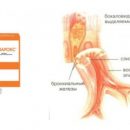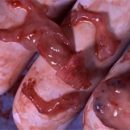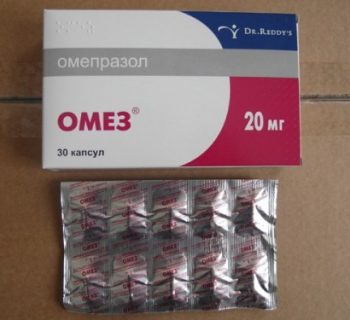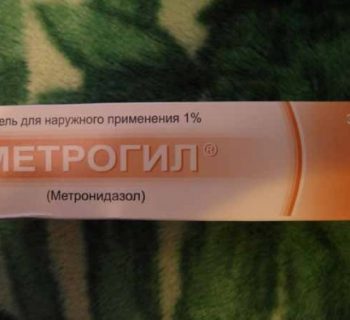Why in the ears it occurs?

All the reasons leading to the appearance of ear tooth are divided into several groups.
- Cutting in the auditory passage of ear sulfur, sometimes even with the formation of traffic jams. This happens due to improper hygienic care for the abnormal sinks, or due to the individual characteristics of the produced sulfur. She protects our ears from foreign particles and dust. And if a person constantly dismounts the whole sulfur from the hearing aisters, it is also harmful.
- Hit in the auditory passage of foreign bodies (for example, various insects, beads, beads and other small elements of life, which often stuff small children in the ears).
- Old age - over the years there is a change in sensitivity properties, involuntary pulses in the nerves can provoke an unpleasant feeling, then it seems that the ears.
- The appearance in the outer hearing aisle of polyps or papillomas - benign neoplasms, having kind of moles, papillas.
- Allergic diseases - their occurrence is associated with an abnormal response of the body on some substances of the external environment, for example, food, medicine, household chemicals ... The body throws a large number of inflammation factors, resulting in leather. With such diseases, not only skin can be amazed, lining the outer hearing pass, but also located in other parts of the body.
- Sugar diabetes - for this disease, the defeat of the nerve endings located on the skin. Therefore, there may be a feeling of itching throughout the body.
- Infectious inflammatory diseases. For example, with chronic otte, the infection penetrates into the hearing pass and the average ear, the defect of the eardrum can be detected, the process is accompanied by itching, a decrease in hearing, ear pain, purulent discharges.
- Ottomikosis - with the disease in the outer hearing pass, fungi penetrate, begin to reproduce actively. In addition to the desire to scratch something inside the ear, the patient is disturbed by pain, unpleasantly smelling discharge from the ear, the feeling of mortgage from the patient's ear.
- Idiopathic itching - such a concept is used if it is not possible to determine the cause of the occurrence of ear. Then it is necessary to carry out an additional or repeated examination of the patient. But it happens that in this case itching is neurogenic, it is associated with the involuntary excitation of nerve cells.
Under a number of diseases of the hearing body, the patient is recommended to be purchased in a pharmacy for the treatment of candibiotic.
General information about the drug
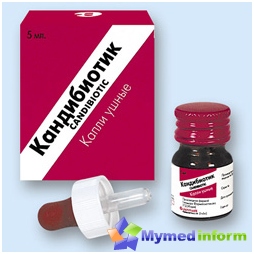
In the package with the inscription «Candibiotic» There is a bottle of dark glass complete with a pipette tube. It is pouring 5 ml of a transparent solution of yellowish tint.
The drug is multicomponent, there are several active substances in the composition:
- Chloramphenicol - this antibiotic has a wide spectrum of therapeutic action, it exhibits bacteriostatic properties, disrupts the normal synthesis of protein in the bacteria cells of both gram-positive and gram-negative.
- Clotrimazole - this antifungal agent also has a wide range of action. It disrupts the production of one of the components of the cell shells of fungal cells, called Ergosterin. The permeability of the membranes of mushroom cells changes, which causes the death of pathological cells.
- Lidocaine - endowed with local properties. Anesthesia occurs due to reversible blockade of pulses on myelin nerve fibers.
- Becmetazone dipropionate - refers to glucocorticosteroids, able to show anti-allergic and anti-inflammatory effects.
Glycerol and propylene glycol are used as auxiliary ingredients.
pharmachologic effect
Due to the combination of several active substances in the drug, anti-inflammatory, painting, antimicrobial, fungicidal (antifungal), antiallergic properties are observed.
Indications for use
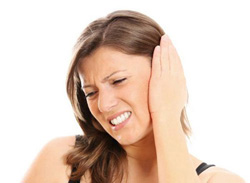
Candibiotic helps to stop inflammatory processes that ferocate with diseases of the ears. These ear drops can be used in allergic reactions that develop in auditory passes.
Candibiotic is prescribed at:
- Symptoms pointing to the beginning of development in the middle ear of acute diffuse otitis (especially in strong pains);
- chronic Otitis;
- allergic diseases accompanied by ear territory;
- Mikosakh, developing in middle ear.
Candibiotic is prescribed to patients after operations performed in the middle ear.
How to apply Candibiotic?
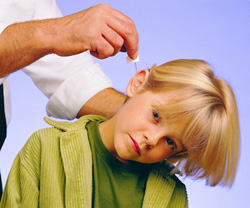
With the help of the pipette attached to the medicine, the candibiotic is introduced into the patient's ear - its outer hearing pass. One-time dose: from three to five droplets. After the desired number of drops will be in a sick ear, it is closed with a clean cotton swab. The procedure is repeated from three to five times a day (this solves the otorinolaryngologist). Patients inform that about the third day from the start of treatment they have improved well-being. The duration of the course should be at least seven days.
About side effects and contraindications
It is not recommended to use these elder drops when:
- development of signs of hypersensitivity to components available in composition;
- Perforation of the eardrum;
- pregnancy and breastfeeding (since there is no sufficient data on the effects of candibiotic on the fruit and the state of the mother's health);
- pathology in the ear taking place on the background of a simple Herpes or windmill.
Candibiotic children can be used if their age is over six years old.
In most cases, the drug is well tolerated, allergic reactions to this medicine were very rarely noticed in patients, they were mainly expressed by burning and itching in the place where droplets were applied.
Itching in the ears, abundant discharge of them, pain, decline in hearing can be signs of serious diseases. Candibiotic - an effective combination drug, but MirSes advantages readers that cannot be engaged in self-medication. Be sure to refer at the first opportunity to ENT doctor.

